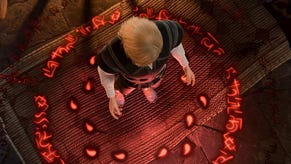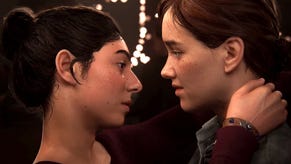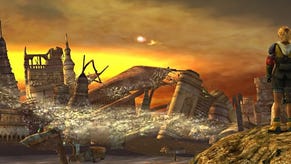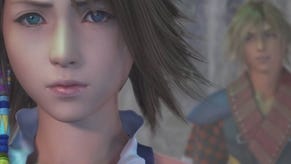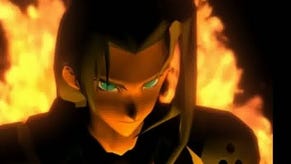Final Fantasy X
Review - Square's PlayStation 2 epic finally hits the West, with aplomb
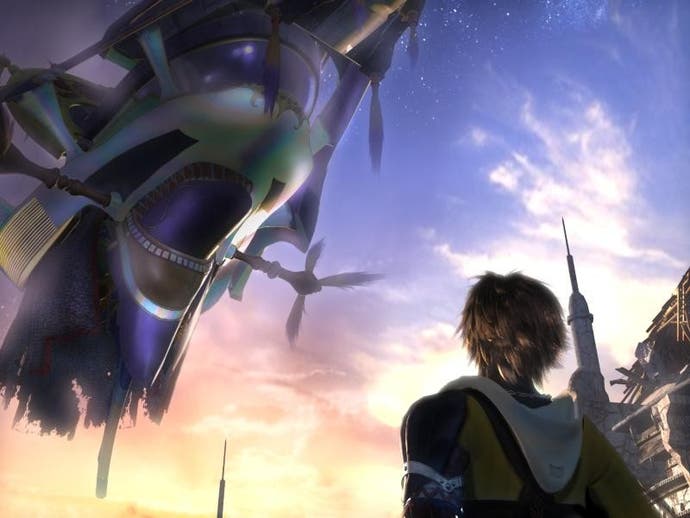
X Marks The Peak
Long-time fans of the Final Fantasy series will know that with the advent of each new platform Squaresoft adopts, enormous leaps are taken in new directions. Final Fantasy II introduced SNES owners to the glory of 16-bit graphics and Cecil's carefully woven story of intrigue showed gamers that Square could do more than just paint and program. Later on, Final Fantasy VII on Sony's fledgling PlayStation ushered in a new era of jaw-dropping CG and polygonal characters fighting in front of beautiful pre-rendered backdrops.
Returning to its roots in many areas, Final Fantasy X is the first of Square's PlayStation 2 RPGs, and with it the developer has reverted to a more dynamic approach, with an emphasis on storyline, battle strategy and emotional attachment. In the graphics department, the firm has moved away from pre-rendered backdrops, preferring to make use of the PS2's polygon-pushing capabilities for the most part, with sections of CG dotted about the game. Character design and animation is stronger than anywhere else in the series, with only the vagaries of the conversion from Japanese NTSC to American NTSC and then PAL giving rise to criticism.
As with many Final Fantasies, the fundamentals of the story are simple enough, but the depth and development of the tale is the clinching factor. You take up the role of a young Blitzball player called Tidus, wrenched from the clutches of stardom in his home of Zanarkand and hurled a thousand years into the future by an enormous sea-dwelling entity called Sin. Finding himself alone and uncertain in the world of Spira, he gradually comes to terms with his predicament and soon joins up with a band of characters guarding the summoner Yuna, whose job it is to try and defeat Sin. She is expected to give her life doing so.

Epic
Tidus and Yuna immediately form an unlikely bond. Yuna is alone amongst the denizens of Spira in believing Tidus' story of Zanarkand, and the pair both know the difficulties of handling fame. After several hours bits of the puzzle start to piece themselves together and the various characters and their back stories all converge to bind the group and the player on an emotional level.
Thanks to the high standards of their artwork, specifically facial animation and body language, and the development of each character and their respective relationships through dialogue and event-driven plot revelations, this Fantasy is transformed into more of a movie than a game at times, although the largely substandard voice acting counts against it to a degree. Listening to the whiny, detestable Tidus chatting to the dainty, dreamy Yuna or the gruff, battle-hardened Auron you feel like batting the casting director around the head with a blunt instrument, and the lack of lip-synch just condemns it further. Final Fantasy X would have worked better as a subtitled Japanese language game, and it's a shame that this isn't an option.
However, Tidus and co. do make much more dignified and believable decisions than those made by their predecessors in other Final Fantasy games. The story moves this way and that to the tune of glorious sandy beaches, sunsets and beautifully animated magical forces and traditions, and gone are the motionless, one-line-only NPCs of previous games, often replaced by impressive bit part characters like the wily old fellow you meet on the road to Djose with his world-weary voice and sage advice.
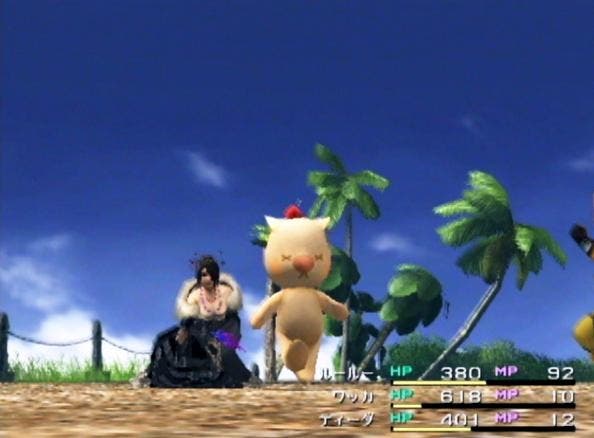
Magical
Behind the glitz and glamour of the fifty hours of story and adventure you have the mechanics of the game. Gone are the simplistic levelling systems of yore, and instead at the heart of the game is the Sphere Grid. Much of the band's path through the game is littered with sinspawn and other adversaries, and when these are defeated your group is endowed with sphere points and different magical spheres, and subsequently sphere levels.
Each level lets you move one space on the enormous Sphere Grid, and your choices here dictate what sort of abilities your character can attain. Lulu, the dark witch, can quickly accumulate powerful attacks, but gaining hit points is irregular by comparison, meaning that she really needs defensive spells cast early by an accomplice to go the distance. Auron, on the other hand, quickly collects massive amounts of hit points to complement his arsenal of devastating sword blows, whilst Yuna herself gathers white magical spells. The Sphere Grid is a nice touch, but having to use it so often it actually takes up a huge chunk of the game. And non-linear though it may seem, thanks to the use of locking mechanisms it will take you a very long time to get characters to deviate from their roughly chosen paths.
The other half of the abilities ladder is Yuna's summoning powers. With each temple that the group visits on its way to the game's conclusion at the top of the world, Yuna collects another creature, or aeon. Doing this is a process of penetrating the maze of tasks beneath the temple - something which Tidus always seems to risk Yuna's excommunication by doing himself - but at times the bizarre use of silly substitution puzzles to reach the other side can be depressing and seems like superfluous padding. Once you have collected them, the aeons fit carefully into the puzzle of Spira and Sin, just as virtually everything else in the game does, and take the form of huge beasts, like the winged Valefor you may have seen in the demo. Aeons can be used to fight in the party's stead until they run out of hit points, and because they embody a certain type of magic they are completely insusceptible to many attacks. But despite my concerns about the development team (who were also responsible for Final Fantasy VIII), aeons never take over the entire battle system as Guardian Forces once did.
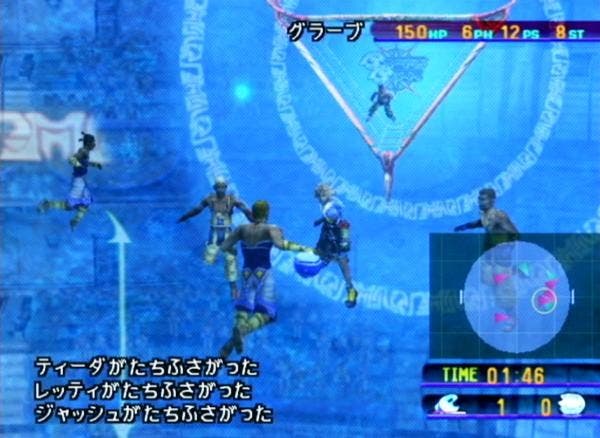
Deep
Defeating enemies is more complex than in previous Fantasies. You can fight with a force of three characters, but you can swap in other members of your team without being penalised, which is often just as critical as landing a heavy blow. During one of the longest sections of repeated fighting about ten hours into the game, you regularly come up against mixtures of fiery floating blobs which self-destruct after three attacks, wild horned beasts in various sizes and floating magical spectres. There are many approaches here. When facing a collection of fiery blobs, you could fight them with Lulu's water spells, but they are often too strong and their persistent flame spells can decimate the party quickly before you can flee, so it often pays to deploy the fiery aeon Ifrit to soak up the toasty attacks like hit points and deal out physical damage until they all self-destruct.
The game's opposing magical forces (lightning/ice, water/fire), of which Lulu is a mistress of all, must be chosen carefully depending on the foe, and other, slower brutes are better dealt with by the swords of Tidus, Auron or the peculiar muted Ronso creature Kimahri. Meanwhile Wakka can dispatch winged creatures with his projectile blitzball attack. Another nuance of the battle system is overdrive attacks. When a character's aggression bar maxes out you can let rip with an overdrive, requiring a quick-fire button combination at the critical moment, which massacres enemies' HP counts.
Final Fantasy X is an extremely epic adventure, and it will come as little surprise that Squaresoft has padded out the world of Spira with countless distractions. Blitzball, of which I made mention earlier, is one of only a handful of constants between Zanarkand and Spira, but it forms the soul of those trying to live in fear of Sin. The spectacular intro (complete with the series-first use of heavy metal music as a backdrop) gives you a vague idea of the sport, but when you actually come to play it for yourself it's a lot different, rather like the Games Workshop oddity Blood Bowl in design. Some will like it, some won't. But only one game is compulsory, even if eager types can form a team and take on the entire world in a blitzball league. Other diversions include the Al Bhed, who speak a curious language decipherable if you manage to collect the various primers hidden around the game world. Fortunately, it's never too late to start playing with the game's intricate extras, and in the lull before the climactic final battle the entire game world opens up like a virtual playground.
Conclusion
I have a few complaints as you can tell, but the good definitely outweighs the bad and this is far and away the most intricate and consistently enjoyable of the Final Fantasy games since the pinnacle of 16-bit RPGs, Final Fantasy VI. The PAL conversion with its enormous borders is a big disappointment, but the strength of the story, the battle system and the combination of clever dialogue, visuals and soundtrack conspire to captivate the player. There are many, many hours of adventuring to be had here, and plenty more mini-games beyond the items mentioned above to enjoy (Chocobos and the Monster Arena, for example). Because it is so enchanting, it's a very hard game to put down for just about anybody, whilst remaining a deceptively complex and enjoyable one for diehards. If you like fantasy, swords, sorcery and love stories then you can't fail to enjoy Final Fantasy X.


